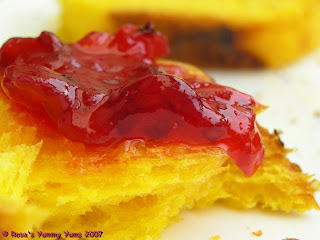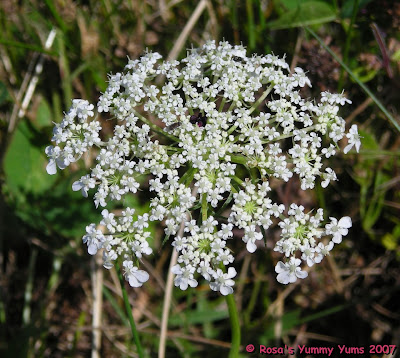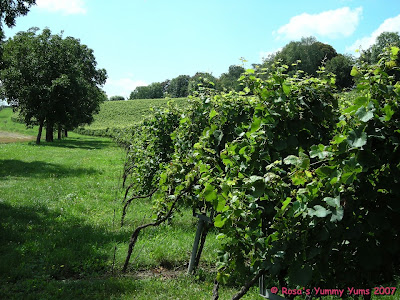This time, I will not repeat myself and speak about it's origins or history (for that, read my older post here), I will only proceed with Maggie Glezer's marvelous recipe...
But, the only thing you need to know about this "Pumpkin Challah" or "Pan De Calabaza" (in Spanish) is that it is a Sepharadic Rosh Hashanah (see infos) bread and that the pumpkin in the recipe has a symbolic meaning. This bread can be compared to the hard shell of the pumpkin that protects it's insides as it is an embodied prayer to God asking him to give his protection to the querant in the coming year.
Anyhow, it is also a bread that can be made on the occasion of Thanksgiving and which is the ideal ally in order to grace the table of all the homebakers at any time of the year, whether they are of Jewish origin or not...
As a challah addict, bread freak, amateur baker and adventurous (I hope...) foodie, this light "Pan De Calabaza" really makes me enthusiastic and fills me up with uncontrolled joy. This non-dairy bread is very easy to make and always gives good results. It's appealing orange color is incredible and the braiding makes it look ever so pretty. Not to forget it's gentle pumpkin and delicate spicy flavor as well as it's sweet and rich scent/taste that will please you with every mouthful. A fabulous bread!


~ Pumpkin Challah Or Pan De Calabaza ~
Recipe taken from Maggie Glezer's cookbook " A Blessing of Bread: The Many Rich Traditions of Jewish Bread Baking from Around the World" and adapted by Rosa @ Rosa's Yummy Yums.Makes 1 big loaf or two smallish loaves.
Ingredients:
1/2 Cup Pumpkin puree (+ more if the dough is too dry) homemade or canned
2 1/4 Tsps (7g) Active dry yeast
1/4 to 1/2 Tsp Ground cardamom
1/2 Tsp Ground ginger
3 3/4 Cups Plain white flour
2/3 Cup Warm water
1/3 Cup sugar
1 1/2 Tsps Salt
1/4 Cup Plain vegetable oil
1 Egg (~53g) + 1 egg (for the glaze), beaten
Sesame seeds or poppy seeds
Method:
1. Sprinkle the yeast into the water in a bowl. Leave four 10 minutes and then stir to disolve.
2. Mix the flour and the spices together in a large bowl, make a well in the centre of the flour and pour in the yeasted water.
3. Use a wooden spoon to draw enough of the flour into the yeasted water to form a soft paste.
 4. Cover with a tea towel and leave to "sponge" until frothy and risen, about 20 minutes.
4. Cover with a tea towel and leave to "sponge" until frothy and risen, about 20 minutes.
5. Whisk the sugar, salt, oil, egg and pumpkin together. Add to the dough and mix well.
6. Knead for at 5-10 minutes.
5. Let the dough rest while you wash and dry your bread bowl.
7. Oil the bowl lightly, put the dough in it, cover the bowl with a towel.
8. Let it rise in a warm place until the dough has tripled in size, about 2-3 hours.
9. Punch it down and shape as you wish (I opted for two braids, which requires halving the dough and then cutting each half into thirds, rolling those thirds into ropes of dough, and braiding the ropes).
10. Place the loaves on baking sheets that have been oiled or sprinkled with cornmeal/flour.
11. Let the loaves rise until at least doubled in size, about 40 minutes to an hour.
12. Glaze the loaves with the extra beaten egg and sprinkle them with sesame seeds or poppy seeds.
13. Bake the loaves at 180° C (350° F) for 40-45 minutes.
Remarks:
Instead of the pumpkin puree, you can use 1 sweet potato (baked, then mashed).
I recommend you to use the following pumpkin:
Potimarron (French) = Hokkaido Pumpkin = Chestnut Pumpkin = Baby Red Hubbard = Uchiki Kuri = Chinese Pumpkin = Japanese Pumpkin.
To obtain fresh puree, take your pumpkin, cut it in half, deseed it and peel it, then cut it in cubes and steam. Once it is cooked, mash the pumpkin flesh. It has to be a very smooth puree.You can add a little more pumpkin puree if you want the flavor to be stronger.
Use plain/neutral tasting oil such as peanut oil, canola oil or sunflower oil.
If you find you dough too wet, add some flour or, on the contrary, if you find it too dry add some pumpkin puree, a tablespoon at a time.
The dough should be firm, easy to knead and neither dry nor sticky.
 Serving suggestion:
Serving suggestion:
This challah can be served on Jewish festive days like Shabbat and Rosh Hashanah, or any other non-Jewish festive days such as Thanksgiving or Christmas/New Year.
Eat for breakfast with jam, honey or the spread of your choice.
When served for dinner or supper, this bread can be accompanied by all sorts of cheeses and pickles/salads/raw vegetables (tomatoes, cucumber, etc...).
 This week, there's nothing particular to declare on the cat front...
This week, there's nothing particular to declare on the cat front... Maruschka was very adorable lately.
Maruschka was very adorable lately.


















































